#43: A Day In The Life by the Beatles
City: Calgary, AB
Radio Station: CKXL
Peak Month: June 1967
Peak Position in Calgary ~ #3
Peak position in Vancouver ~ Hitbound
Peak Position on Billboard Hot 100 ~ did not chart
YouTube: “A Day In The Life”
Lyrics: “A Day In The Life”
Paul McCartney was born in Liverpool in 1942. He attended the Liverpool Institute High School for Boys and met fellow classmates George Harrison on a school bus. When Paul was 14 his mom died from a blockage in one of her blood vessels. In his early teens McCartney learned to play trumpet, guitar and piano. He was left-handed and restrung the strings to make it work. In 1957, Paul met John Lennon and in October he was invited to join John’s skiffle band, The Quarrymen, which Lennon had founded in 1956. After Paul joined the group his suggested that his friend, George Harrison, join the group. Harrison became one of the Quarrymen in early 1958, though he was still only 14. Other original members of the Quarrymen, Len Garry, Rod Davis, Colin Hanton, Eric Griffiths and Pete Shotton left the band when their set changed from skiffle to rock ‘n roll. John Duff Lowe, a friend of Paul’s from the Liverpool Institute, who had joined the Quarrymen in early 1958 left the band at the end of school. This left Lennon, McCartney and Harrison as remaining trio. On July 15, 1958, John Lennon’s mother died in an automobile accident.
John Winston Lennon was born in Liverpool in 1940. His middle name was after Britain’s current Prime Minister Winston Churchill, during World War II. In 1957, Lennon wrote his first song titled “Hello Little Girl”. It became a Top Ten hit in the UK in 1963 for the Merseybeat band the Fourmost. George Harrison was born in Liverpool in 1943. His father bought him his first guitar in 1956 when Harrison was 13 years old.
Richard Starkey was born in Liverpool in 1940. As a child he was sick with appendicitis, peritonitis and finally tuberculosis. The latter illness had him spend two years in a sanitorium from 1953 to 1955. Out of school for this duration, Starkey remained at home after his return from the sanatorium. He got involved with a skiffle band initially called the Eddie Miles Band which morphed into Eddie Clayton and the Clayton Squares. Starkey next joined Al Caldwell’s Texans which eventually became Rory Storm & The Hurricanes. By the fall of 1959, Starkey changed his professional name to Ringo Starr and his drum solos during their concerts were billed as ‘Starr Time.’ Beginning October 1, 1960, Rory Storm & The Hurricanes began a gig at the Kaiserkeller club in Hamburg, Germany. They alternated sets with The Beatles. On October 18, 1960, with Pete Best on an errand to find drumsticks, Ringo Starr stood in for Best to play a set with McCartney, Lennon and Harrison. This was the first time the Fab Four performed together.
The Quarrymen went through some name changes, including Johnny and the Moondogs. In January 1960, Stuart Sutcliffe joined the band and suggested they name themselves the Beatals as a tribute to Buddy Holly and The Crickets. The name changed to the Silver Beetles in May and in August 1960 they became the Beatles. The name was a cross between the insect cousin of a cricket and a nickname for rock ‘n roll: ‘the beat’. That same month the Beatles hired Pete Best to become the bands drummer. Now a five-piece band, they headed to Hamburg, Germany, on August 17, 1960, for a three-and-a-half month stint. In early 1961 Sutcliffe left the Beatles as they continued to return for more engagements in Germany. On June 22, 1961, Bert Kaempfert produced “My Bonnie”, “Ain’t She Sweet” and eight other songs. Later in 1961, “My Bonnie” climbed to #4 on the Hamburg pop charts and #32 on the German pop charts.
Meanwhile, the Beatles were developing a following back in Liverpool. Between February 9, 1961, and August 3, 1963, the group played at The Cavern Club 292 times. The group got a recording contract with EMI’s Parlophone label in the UK. At the June 6, 1962, studio session, producer George Martin objected to Pete Best remaining with the Beatles due to his poor drumming skills. In August Ringo Starr from Rory & The Hurricanes accepted Paul McCartney and John Lennon’s invitation to became the Beatles new drummer. The first EMI Parlophone single “Love Me Do”/”PS I Love You” climbed to #17 on the UK charts in the fall of 1962. “Please Please Me” climbed to #2 on the UK pop charts in early 1963. And in April 1963 “From Me To You” became the bands first #1 hit on the UK charts staying on top for seven weeks in a row. It became the first Beatles song on the Vancouver pop charts was in June 1963. It charted on C-FUN together with the cover version by Del Shannon. The song stalled at #116 on the Billboard Hot 100, but the Beatles climbed to #14 in Vancouver in July ’63.
In 1963 “She Loves You” topped the UK charts for six weeks and “I Want To Hold Your Hand” wrapped up the year on top for five weeks in the British Isles. Beginning on December 21, 1963, “She Loves You” topped the C-FUN charts for four weeks. It was replaced on January 18 by “Please Mister Postman”.
On the C-FUN charts in Vancouver on January 25 “I Wanna Hold Your Hand” began a six week stint at number-one. On March 7 “All My Loving” took over the #1 spot, subsequently sharing the #1 spot with the B-side “This Boy” through to April 4.
After sixteen weeks at #1 the Beatles were knocked out of the top spot by the Dave Clark Five’s “Bits And Pieces”. During their streak at #1 in Vancouver from December 21, 1963, to April 4, 1964, “All My Loving”/”This Boy” kept the #1 hit in the USA, “Can’t Buy Me Love” stalled at #2 here on the west coast. Between December 14, 1963, and September 17, 1966, the Beatles had up to five songs in the Top Ten in Vancouver for 107 out of 146 weeks.
Beatlemania – the frenzy for all things related to the Beatles from their records, to appearances – officially reached North America with three appearances on the Ed Sullivan Show in February 1964. But in Vancouver the Beatles were already a craze by December ’63. In April 1964 the Beatles released The Beatles’ Second Album. It featured a number of tracks that were hit singles. These included “Thank You Girl”, “She Loves You”, “Please Mr. Postman”, “You Can’t Do That” (also released as a track on A Hard Days Night). In June the German version of “She Loves You” titled “Sie Liebt Dich” began to chart, and became a Top Ten hit in Vancouver in July.
In June the band released the film and soundtrack album A Hard Days Night. The theme song from the film climbed to number one in August. The B-side in North America to “A Hard Day’s Night” was “I Should Have Known Better”. (In the UK the B-side was “Things We Said Today”). Then in July the Beatles released Something New. The album contained the following single releases: “I’m Happy Just To Dance With You”, “I’ll Cry Instead“, “Things We Said Today”, “Matchbox”, “Tell Me Why”, “And I Love Her”, and “If I Fell“.
In 1965 the Beatles had two number-one hits to start off the year: “Eight Days A Week” in March, and “Ticket To Ride” in May. In Vancouver, the B-side “Yes It Is” also charted. In the summer of 1965 the Beatles kept on releasing number-one hits. “Help!” had a B-side titled “I’m Down“. The next release, “Yesterday”, was a number-one hit in Vancouver, as was the B-side “Act Naturally”.
On October 1965, the Beatles were back on top of the pop charts with “Yesterday”, and “Day Tripper”/”We Can Work It Out” in December. In early 1966 the Beatles were back in the Top Ten in Vancouver with “Michelle”/”Norwegian Wood”. Their next chart-topper in Vancouver was “Nowhere Man”. The B-side, “What Goes On”, was also a hit in the city.
In March 1966, John Lennon had an an interview with Evening Standard reporter Maureen Cleave. Lennon commented, “Christianity will go. It will vanish and shrink … We’re more popular than Jesus now—I don’t know which will go first, rock and roll or Christianity. Jesus was all right but his disciples were thick and ordinary.” The comment was yawned at in Britain, but it caused a furore when it was reported in Datebook’s August edition in America. Suddenly there were protests that involved the burning of Beatles records. The Ku Klux Klan staged protests against the Beatles and nailed their albums to a wooden cross. There were also death threats against Lennon. This development was a catalyst for the band’s decision to cease touring. On August 19th two concerts were scheduled in Memphis, Tennessee. Both were cancelled by the city council who wouldn’t let municipal facilities be used by people who were trying to “ridicule anyone’s religion.” Meanwhile, the Fab Four had more hit records including “Nowhere Man” and “Paperback Writer”. The B-side to “Paperback Writer” was “Rain“.
Next up, the Beatles released “Yellow Submarine”/”Eleanor Rigby”. In 1967 the band enjoy Top Ten hits with “Penny Lane”/”Strawberry Fields”, “All You Need Is Love” and “Hello, Goodbye”/”I Am The Walrus”. That year the band released Sgt. Pepper’s Lonely Hearts Club Band, which topped the Billboard 200 Album charts for 15 weeks. From the album a number of non-single album charts made a few Top 40 AM radio markets based on listener requests. One of these was “When I’m Sixty-Four”. Another was “A Day in The Life”.
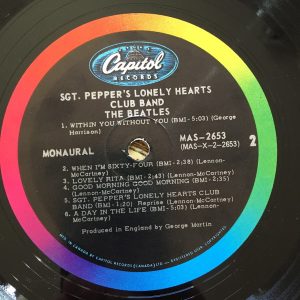
A 41-piece orchestra played on this song. The musicians were told to attend the session dressed formally. When they got there, they were presented with party novelties (false noses, party hats, gorilla-paw glove) to wear, which made it clear this was not going to be a typical session. The orchestra was conducted by Paul McCartney, who told them to start with the lowest note of their instruments and gradually play to the highest. As the musicians were used to only playing notes on a music sheet, Paul McCartney recalls, “George Martin, the producer, said to the orchestra, ‘You should leave this note at this point in the song, and then you should go to this note and this note,’ and he left the random thing, so that’s why it sounds like a chaotic sort of swirl. That was an idea based on the avant-garde stuff I was into at the time.”
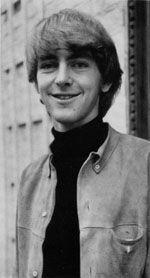
21-year-old Tara Browne died on December 17, 1966
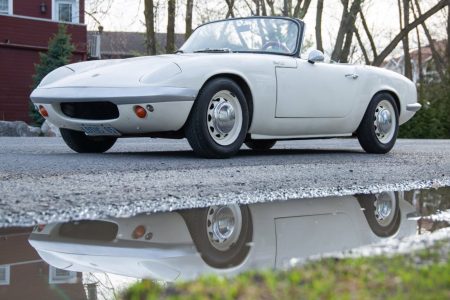
Lotus Elan S1 – Tara Browne drove a white one of these into a parked lorry at Radcliffe Square in London
Regarding the article about Tara Browne, John Lennon stated: “I didn’t copy the accident. Tara didn’t blow his mind out. But it was in my mind when I was writing that verse.” Lennon was a friend of 21-year-old Tara Browne, and some of the lyrics resembled what the coroner’s verdict was regarding the young man’s death. Browne was driving with his girlfriend through the London neighborhood of South Kensington at 170 km/per hour. He was under the influence of alcohol and other drugs at the time. Browne failed to see a traffic light and proceeded through the junction of Redcliffe Square Redcliffe Gardens, colliding with a parked lorry. He died of his injuries the following day. His girlfriend survived the crash.
Tara Browne was the first person who gave Paul McCartney LSD. At the time, Paul McCartney didn’t realize the lyrical reference was to Tara Browne. He thought it was about a “stoned politician.” However, in 2021, in McCartney’s book, The Lyrics, he concedes that the lyrics were about Tara Browne.
The second article was in the UK Daily Express on January 17, 1967, titled “Far And Near.” It told of how the Blackburn Roads Surveyor had counted 4000 holes in the roads of Blackburn and commented that the volume of material needed to fill them in was enough to fill the Albert Hall. The article inspired the third verse in the song. John Lennon’s friend Terry Doran was the one who suggested John’s line, “Now they know how many holes it takes to fill…” Terry told Lennon, “fill the Albert Hall, John.”
McCartney contributed the line “I’d love to turn you on.” This was a drug reference, but the BBC banned it because of another section, which they assumed was about marijuana:
Found my way upstairs and had a smoke
Somebody spoke and I went into a dream
The ban was finally lifted when author David Storey picked it as one of his Desert Island Discs.
Verse two details how the narrator saw a film where “the English Army had just won the war.” Though box office sales were slow, the narrator chooses to see the film, “having read the book.” In 1963, Patrick Moore wrote a satirical novel titled How I Won The War. In 1967, it was made into a film which starred John Lennon and Michael Crawford. The plot concerns Lieutenant Goodbody, an inept, idealistic, naïve, and almost relentlessly jingoistic wartime-commissioned (not regular) officer. One of the main subversive themes in the film is the platoon’s repeated attempts or temptations to kill or otherwise rid themselves of their complete liability of a commander.
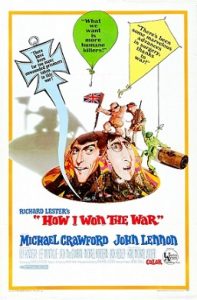
1967 poster for How I Won The War
Lennon, taking a break from the Beatles, was asked by Lester to play Musketeer Gripweed. The film was made in the fall of 1966, and shot in Lower Saxony in Germany, and the province of Almería in Spain. To prepare for the role, Lennon had a haircut, contrasting sharply with his mop-top image. During filming, he started wearing round “granny” glasses (the same type of glasses worn by the film’s screenwriter, Charles Wood). The “granny” glasses became iconic as the nearsighted Lennon mainly wore this particular style of glasses for the rest of his life. A photo of Lennon in character as Gripweed found its way into many print publications, including the front page of the first issue of Rolling Stone in November 1967.
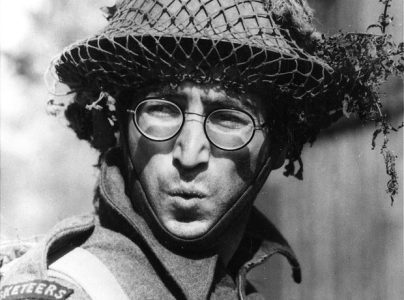
John Lennon as Musketeer Gripweed in How I Won The War
As well, Lennon saw vegetation at the villa in Spain while on location, which reminded his of Strawberry Field near his childhood home. It inspired the lyrics for “Strawberry Fields Forever”. A 2013 Spanish film, Living Is Easy with Eyes Closed, revolves around the filming in Almería.
Though it was not a single, and issued as a track from Sgt. Pepper’s Lonely Hearts Club Band, “A Day In The Life” charted to #1 in Los Angeles, and San Diego, #3 in Calgary, #5 in Worcester (MA), #6 in Seattle, and #13 in Jacksonville (FL).
In early 1968 the band had another hit single with “Lady Madonna”. The B-side, “The Inner Light”, also charted in Vancouver. The Beatles would become the most influential rock ‘n roll band of the 20th Century. They have sold over one billion records. They began recording upbeat love songs like “I Want To Hold Your Hand” and later composed more complex songs, including on their award-winning 1967 album, Sgt. Pepper’s Lonely Hearts Club Band. The Beatles were on the cusp of whatever was new and were often the trend-setting reason for the next new thing. In 1967 they got involved with Transcendental Meditation. When they released “Hey Jude,” they had one of those rare singles that was longer than 7 minutes climb to the top of the charts. At the time, the standard formula for singles was around two to three minutes in length.
In 1969, the Beatles had more hit records with “Get Back” and “The Ballad of John & Yoko”. The B-side for the latter was “Old Brown Shoe”.
The band’s final hit singles were “Something”/”Come Together”, “Let It Be” and “The Long And Winding Road”. The Beatles split in 1970 after the release of the Let It Be album. Paul McCartney told Howard Stern in 2018 that John Lennon walked into a room one day in 1970 and announced that he was leaving the Beatles.
For more information about the Beatles after the 1970 breakup, see my other articles on the band.
April 6, 2024
Ray McGinnis
References:
David Fricke, “Paul McCartney Looks Back: The Rolling Stone Interview,” Rolling Stone, August 10, 2016.
Ben Quinn, “Paul McCartney ‘saw God’ After Taking Drugs During Beatles Heyday,” Guardian, September 2, 2018.
Stephen Rodrick, “Being Ringo: A Beatle’s All-Starr Life,” Rolling Stone, April 15, 2015.
“Interview: John Lennon and Ringo Starr in Los Angeles,” Los Angeles Times, August 23, 1964.
Mick Brown, “A Conversation With George Harrison: The ‘Fab Four’ is Done For, and George Couldn’t be Happier Doing his Own Thing,” Rolling Stone, April 19, 1979.
Dave Laing and Penny Valentine, “George Harrison: The Most Handsome but Underrated Beatle, he Came into his Own as a Solo Artist and Film Producer,” Guardian, December 1, 2001.
“John Lennon Died 35 Years Ago Today: Read Original Associated Press Story,” Billboard, December 8, 2015.
Johnathan Cott, “John Lennon: The Last Interview: Three days before he died, John Lennon talked with ‘Rolling Stone’ for nine hours. For the first time, we present this extraordinary interview,” Rolling Stone, December 23, 2010.
Barry Miles, Beatles in their Own Words, Putnam Pub. Group, 1978.
Kit Ward, “Tara Browne’s fatal crash: ‘Like a death knell sounding over London’,” theseislands.blog, December 29, 2019.
Paul McCartney, The Lyrics: 1956 to the Present, (WW Norton, 2021).
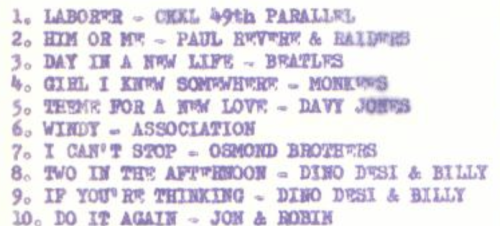
CKXL 1140-AM Calgary (AB) Top Ten | June 5, 1967
Note: This week CKXL station rendered “A Day In The Life” on their pop survey as “Day In A New Life” – go figure

Regarding that CKXL typo: I guess for the fellow in the song who “blew his mind out in a car” it was quite possibly a “day in a new life” on the other side of this mortal plane.
I was in Grade 7 when I first heard a sneak preview on CFUN of the shorter version of Sgt. Pepper’s Lonely Hearts Club Band segued into A Day In The Life. As I recall It was an over-the-phone relay from CJME in Regina which had its own link to a New York City radio station. All in all, the sound quality was quite good.
It aired late enough in the evening on CFUN that none of my classmates heard it. The next day, I had a heck of a time trying to describe what I’d listened to, what with the brief animal noises that preceded Paul McCartney’s “1, 2, 3, 4” intro and the crowd noises at the start of the rockin’ Sgt. Pepper’s Reprise, and then the virtually indescribable magic of A Day In The Life.
Classmates didn’t have to wait long, however, because about a week later, on May 26/1967, Capitol Records officially released the Sgt. Pepper’s Lonely Hearts Club Band album. History ensued.
I was taken out of elementary school in late May 1967. My parents and brother went on a trip to Expo ’67 in Montreal. A long drive, and hit a deer in the forests of northern Michigan on the way back. This delayed our return for a week as we waited for some engine parts to be sent from Duluth (MN) to a local auto repair shop near our motel. For music, we listened to what was on the jukebox, and so it wasn’t until we got back in early July that I caught up with the new music flooding the airwaves in Vancouver: Sgt. Pepper’s album, Surrealistic Pillow tracks and The Doors, among others. A great time for pop music.